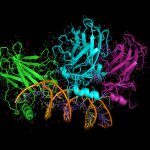Link to Pubmed [PMID] – 1375451
Biochem J 1992 May; 283 ( Pt 3)(Pt 3): 823-8
Denaturation of Bordetella pertussis fimbrial preparations by guanidinium hydrochloride (GdnHCl) has been characterized using static light scattering, c.d., fluorescence and antibody recognition. The susceptibility of Fim2 + 3 (a mixed preparation of two fimbrial types) to GdnHCl was found to be highly dependent on pH; as the pH was increased from pH 7.2 to 10.5, the concentration of GdnHCl required to induce 50% denaturation was decreased. At pH 10.5, Fim2 + 3 was denatured by GdnHCl in a three-step pathway comprising: (1) formation of a pre-denaturational intermediate at less than 1.0 M-GdnHCl; (2) dissociation of the fimbrial polymer into subunits between 2 M- and 3.2 M-GdnHCl; and (3) subunit unfolding between 2.8 M- and 3.6 M-GdnHCl. A similar pathway was also found for the denaturation of the individual fimbrial types, Fim2 and Fim3, except that unfolding of either subunit commenced at a lower GdnHCl concentration (2.2 M) than that found for the mixture of fimbriae, Fim2 + 3. The second step in the denaturation pathway, dissociation into subunits, was partially reversible, but the renaturation and reassociation of fully unfolded subunits to form fimbriae-like structures was not achieved. These findings demonstrate that the GdnHCl denaturation of complex polymeric proteins is unlikely to follow a reversible two-state denaturation pathway, and support the involvement of a chaperone-like protein in the folding and assembly of the fimbriae in vivo. Measurement of the ability of anti-fimbrial monoclonal antibodies to recognize intermediates in the denaturation pathway enabled the identification of two types of epitope which were dependent on different aspects of fimbrial tertiary/quaternary structure.


